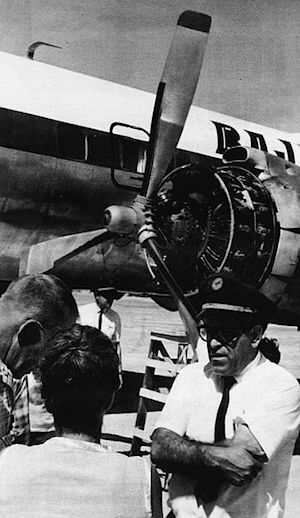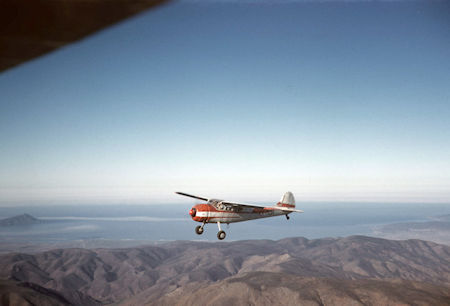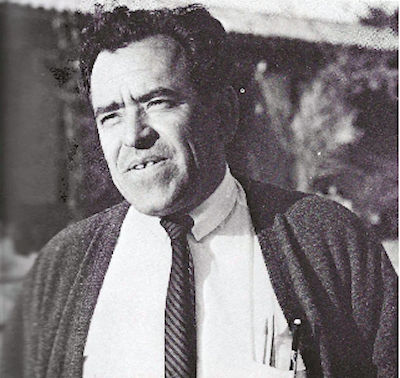 |  |
By Greg Niemann

During the middle years of the 20th century poor and non-existent roads throughout Baja California gave birth to daring and legendary bush pilots. From the 1930s to the 1970s flying was in many cases the only way to visit some ranchos, towns, remote sites, and most of the new resorts.
In the eyes of many, the greatest of the Baja bush pilots has unquestionably been Captain Francisco Muñoz, a former lobster pilot who became known for transporting sportsmen and adventurers in all types of weather and conditions.
The mystery writer Erle Stanley Gardner, better known for his Perry Mason series than his seven books on Baja California, often called upon Captain Muñoz to get him into and out of some extremely remote locations. Gardner constantly spoke in awe of the affable pilot.
Captain Muñoz was born in Coahuila, Mexico in 1919. To fulfill a childhood aviation dream, he worked as a butcher after high school to pay for flight lessons. He earned his private pilot’s license two months after his 18th birthday, and after securing his commercial license joined Aeronaves de Mexico, a new airline based in Mexico City.

He also bought a plane for use on weekends and, little by little, starting flying people around Mexico. He even developed into being the pilot for Mexican president Miguel Aleman during a campaign. Muñoz then became a U.S. resident, living in Texas with his wife and their 4 children. He began selling Piper planes, and then started a charter business which took him to San Diego.
There, he was encouraged by Jim Bracamontes, owner of Jimsair Aviation, to run a charter service out of Tijuana. In 1955, Muñoz moved with his family to Imperial Beach and started flying over Baja. In 1955, he started Baja Airlines with a four-passenger Cessna 170 and established residences in Imperial Beach and Bahia de los Angeles.
He began with providing service from Tijuana to the Bay of Los Angeles, primarily deep-sea fishing parties. Antero Diaz, who ran the only hotel in the small town, welcomed him along with the private aircraft that were also flying into the small runway there.
With Baja Airlines, Muñoz often flew private customers to Baja locations. He became known to the Hollywood crowd shuttling such personages as Fred Astaire, Leo Carillo, James Arness, Chuck Connors and Desi Arnaz.
Travel agents in San Diego and Los Angeles also sent him clients from all over the West Coast. Muñoz had flyers printed, that read: “Bay of Los Angeles—The Fabulous Fishing Resort in Baja California.”
In the early days, Muñoz remembers that there weren’t enough people so he admitted even flying illegally from Tijuana to Cedros Island, without informing the authorities. He shuttled supplies there on his way to and from Bahia de Los Angeles.
He was also hired by the Ensenada fishing cooperative which maintained radio communication with the lobster camps, When a pickup was needed, the cooperative would call Muñoz, who headed to the camps along the Pacific Coast, where primitive and rough runways had been built and maintained by the co-op. Muñoz said he brought fishermen food and cigarettes, and they threw shells full of live lobsters into a large tank inside the plane, about 6,000 pounds of lobsters on a typical trip.

Muñoz’ knowledge about where one could land a plane in Baja was legendary. Arnold Senterfitt, author of the definitive Airports of Baja California (1966), in the book’s introduction thanked Captain Francisco Muñoz for “the help he gives all tourist pilots in Baja California.”
Marvin Patchen, author of Baja Adventures by Land, Sea and Air, (Baja Trail Publications,1981), reported that he was fortunate to meet a pilot who worked for Muñoz, Victor Corral, who “marked airstrips that were not depicted on my World Aeronomical Chart and crossed off many that were inaccurate.”
Marveling over the skill of the Baja bush pilots, Gardner explains in Hovering Over Baja (his first Baja book): “So these Baja California pilots learn to fly by instinct, the seat of their pants, an inherent skill and a daring resourcefulness which puts them out in front as the world’s best and most daring fliers. My friend Francisco Muñoz is one of these pilots.”
Later, Gardner remarked on Muñoz departing from an extremely short mountainous strip:
“I watched with my heart in my mouth as Muñoz took off from that landing strip. From our vantage point in the helicopter poised a couple of hundred feet above the landing strip, we could see the whole procedure, and as Muñoz started lifting the plane into the air, I felt certain he wasn’t going to make it.
“As Muñoz explained to me later, on a short landing strip it is always advisable to take advantage of all the landing strip there is. Some people, he explained, get nervous and try to use only half or three-quarters of the strip. Muñoz takes it all.”

By his seventh Baja book, Gardner had offered many instances of Muñoz’s flying prowess. In Off The Beaten Path in Baja Gardner relates being caught in a storm over northern Baja on a trip from Tijuana to Mulegé. Along with Muñoz and Gardner were Jean Bethell and writer Choral Pepper, editor of Desert Magazine.
Gardner described the adventure in which Muñoz tried different altitudes, circled and circled waiting for the weather to break, and finally dropped the plane down real low to follow the coastline to where he could safely land at Hattie Hamilton’s Sky-Ranch.“We taxied up to the Sky-Ranch—just about the most welcome sight I had ever seen in my life,” admitted Gardner, who immediately asked where the men’s room was.
Francisco Muñoz knew not only Hattie Hamilton but was a longtime friend of the Meling family, who settled and operated Meling’s Ranch in the mountains where they maintained a serviceable uphill airstrip. He also knew the proprietors of most of the other remote ranchos.
From his original plane, Muñoz branched out until he ran a small airline serving Baja and parts of mainland Mexico. He also chartered flights like those for Gardner. He used to fly author Marion Smothers (Vintage Baja, 1993) and her parents to Bahia de los Angeles.

Tom Miller’s Baja Book III (1989) calls Captain Muñoz Baja’s “Numero Uno” pilot: “Few people become legends in their own time, but captain Francisco Muñoz became one nearly a half-century ago. …A large percentage of the small dirt strips in Baja, and some of the paved landing fields, would probably not exist had it not been for this amazing man. His expertise in getting in and out of tight quarters has led to many stories, one of which is that Captain Muñoz can make a wheelbarrow fly and can land a DC-6 in a sand trap. But his true exploits are in the supplying of remote ranchos and fishing villages, and his roles in countless search and rescue missions.”
Erle Stanley Gardner’s books featured numerous photos of Señor Muñoz. You could easily identify the dapper pilot as he was often the only guy in Gardner’s remote camps wearing a tie.
He expanded his service to fly teams of oceanographers into Baja for research. The oceanographers' projects led to the establishment of D.K. Ludwig's expansive salt works at Guerrero Negro Lagoon.
From 1974 until his retirement in 1983, Captain Muñoz worked full-time as the chief pilot for Exportadora del Sal, the operators of the salt works. His assignment: shuttling plant personnel back and forth to San Diego and to mainland Mexico.
Captain Francisco Muñoz, who had been living with his family in their Crest, CA, home (east of San Diego), died in March 2006 at the age of 86.
Fellow Baja authors and writers Fred Hoctor, Ann Hazard and Lynn Mitchell are among those who have also had their own Francisco Muñoz stories. I’ve never been fortunate enough to have flown with him, but when I met Captain Muñoz I knew then that I had shaken hands with a true Baja legend.

They are so easy to deal with. They provide great communication. A real sense of comfort while...

Quick, easy, well designed website and not just for Baja. Good rates for temporal residente...

Thank you for the great service and providing insurance for my F-250. I left a message on a...